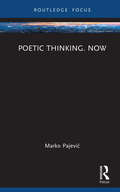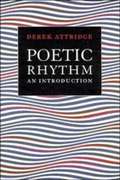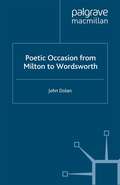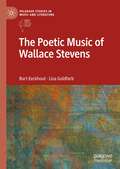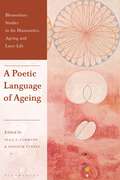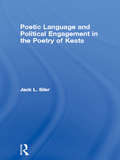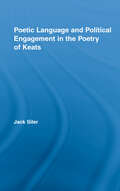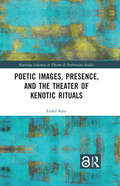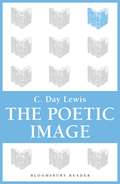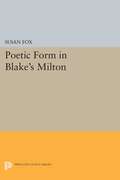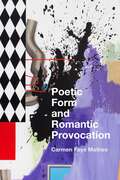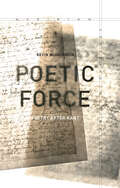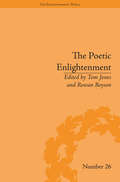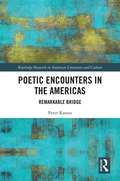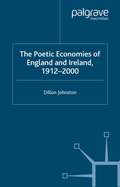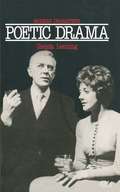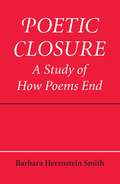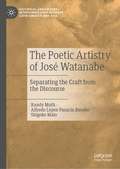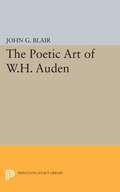- Table View
- List View
Poetic Thinking. Now (Routledge Focus on Literature)
by Marko PajevićThis book presents my concept of poetic thinking in the context of debates around the anthropological question, that is ‘what is being human?’, building on ‘thinking language’ and dialogical thinking, developing a poetological anthropology. It evokes political and social issues to demonstrate why poetics is of general relevance for our times. The chapters relate these questions to insights of quantum physics and neurosciences and discuss aspects of contemporary technology, media and medicine, employing notions such as atmospheres, immanent transcendence, silence and presence from contemporary thinkers. Poetic thinking considers the world in its togetherness, offering an alternative to the opposition of subject and object. It demonstrates the transformative power in the interaction of the form of language and the form of life. Poetic thinking takes place when a subject constitutes itself in creative and dialogical language, transforming its ways of feeling and thinking, in short, its way of perceiving the world.
Poetic Rhythm: An Introduction (PDF)
by Derek AttridgeThis is the first introduction to rhythm and meter that begins where students are: as speakers of English familiar with the rhythms of ordinary spoken language, and of popular verse such as nursery rhymes, song and rap. Poetic Rhythm builds on this knowledge and experience, taking the reader from the most basic questions about the rhythms of spoken English to the elaborate achievements of past and present poets. Terminology is straightforward, the simple system of scansion that is introduced is suitable for both handwriting and computer use, and there are frequent practical exercises. Chapters deal with the elements of verse, English speech rhythms, the major types of metrical poetry, free verse, and the role of sense and syntax. Poetic Rhythm will help readers of poetry experience and enjoy its rhythms in all their power, subtlety and diversity, and will serve as an invaluable tool for those who wish to write or discuss poetry in English at a basic as well as a more advanced level.
Poetic Rhythm: Structure and Performance -- An Empirical Study in Cognitive Poetics
by Reuven TsurThis research is an instrumental investigation of a theory of rhythmical performance of poetry, originally propounded speculatively in the author's Perception-Oriented Theory of Metre (1977). "Iambic pentameter" means that there is a verse unit consisting of an unstressed and a stressed syllable (in this order), and that the verse line consists of five such units. In the first 165 verse lines of Paradise Lost there are two such lines. The theory takes up one of the central issues in metrical studies: all criteria for metricality hitherto proposed have been violated by the greatest masters of musicality in English poetry. The question arises, how do we recognise two verse lines that are very different in their structures as instances of the same abstract pattern of, eg: iambic pentameter; and how do we distinguish a metrical from an unmetrical line. One great difference between this theory of metre and others concerns the status of deviation. Most theoreticians deploy a battery of tools to make deviant stress patterns conform with metric pattern. Only when all attempts fail do they speak of "tension". When they succeed, they blur the distinction between, for example, Milton's and Pope's metrical styles. Or else, they have formulated different rules of metricality for Shakespeare and Milton. This theory assumes that when the versification patterns and linguistic patterns conflict, they can be accommodated in a pattern of "Rhythmical Performance" -- namely one in which the conflicting patterns are simultaneously perceptible. There are scales of mounting difficulties of mismatches, on which each poet (and each theorist) draws at different points the boundary of what is acceptable. Reuven Tsur's revised and expanded edition (original publication, Peter Lang, 1986) is essential reading for all scholars and students involved in versification and Cognitive Poetics.
Poetic Occasion from Milton to Wordsworth (Early Modern Literature in History)
by J. DolanJohn Dolan takes a new approach to the evolution of the modern English lyric, emphasising the way in which several generations of poets, reacting to post-Reformation readers' dislike for invented poetic narratives, competed for the right to commemorate important public occasions and slowly expanded the range of acceptable occasion. This book demonstrates that many fundamental features of a typical modern lyric actually evolved as responses to the limitations of occasional poetry.
The Poetic Music of Wallace Stevens (Palgrave Studies in Music and Literature)
by Bart Eeckhout Lisa GoldfarbWallace Stevens’s musicality is so profound that scholars have only begun to grasp his ties to the art of music or the music of his own poetry. In this study, two long-time specialists present a polyphonic composition in which they pursue various interlocking perspectives. Their case studies demonstrate how music as a temporal art form may affect a poetic of ephemerality, sensuous experience, and affective intensification. Such a poetic, they argue, invites flexible interpretations that respond to poetry as an art of textual performance. How did Stevens enact the relation between music and memory? How can we hear his verse as a form of melody-making? What was specific to his ways of recording birdsong? Have we been missing the latent music of Richard Strauss, Gustav Mahler, and Claude Debussy in particular poems? What were the musical poetics he shared with Igor Stravinsky? And how is our experience of the late poetry transformed when we listen to a musical setting by Ned Rorem? The Poetic Music of Wallace Stevens will appeal to experts in the poet’s work, students of Modernism in the arts, and a wider audience fascinated by the dynamics of exchange between music and poetry.
A Poetic Language of Ageing (Bloomsbury Studies in the Humanities, Ageing and Later Life)
by Olga V. Lehmann and Oddgeir SynnesExploring the potential of poetry and poetic language as a means of conveying perspectives on later life, this book examines questions such as 'how can we understand ageing and later life?' and 'how can we capture the ambiguities and complexities that the experiences of growing old in time and place entail?' As poetic language illuminates, transfigures and enchants our being in the world, it also offers insights into the existential questions that are amplified as we age, including the vulnerabilities and losses that humble us and connect us. This volume suggests a path towards the poetics of ageing by means of presenting analyses of published poetry on ageing ranging from William Shakespeare to George Oppen; the use of reading and writing poetry among lay people in old age, including persons living with dementia; and the poetic nuances that emerge from other literary practices and contexts in relation to ageing – counting personal poetic reflections from many of the contributing authors
A Poetic Language of Ageing (Bloomsbury Studies in the Humanities, Ageing and Later Life)
Exploring the potential of poetry and poetic language as a means of conveying perspectives on later life, this book examines questions such as 'how can we understand ageing and later life?' and 'how can we capture the ambiguities and complexities that the experiences of growing old in time and place entail?' As poetic language illuminates, transfigures and enchants our being in the world, it also offers insights into the existential questions that are amplified as we age, including the vulnerabilities and losses that humble us and connect us. This volume suggests a path towards the poetics of ageing by means of presenting analyses of published poetry on ageing ranging from William Shakespeare to George Oppen; the use of reading and writing poetry among lay people in old age, including persons living with dementia; and the poetic nuances that emerge from other literary practices and contexts in relation to ageing – counting personal poetic reflections from many of the contributing authors
Poetic Language and Political Engagement in the Poetry of Keats (Studies in Major Literary Authors)
by Jack L. SilerIn this incisive volume Siler traces the uneasy relationship between the content of Keats' poems and social history. In the process, he discovers that the early poems are linked with the mission statement of the radical journal Annals of the Fine Arts, whilst the poems after Endymion reveal a poet more concerned with the nature of poetic representation--its why and wherefore.
Poetic Language and Political Engagement in the Poetry of Keats (Studies in Major Literary Authors)
by Jack L. SilerIn this incisive volume Siler traces the uneasy relationship between the content of Keats' poems and social history. In the process, he discovers that the early poems are linked with the mission statement of the radical journal Annals of the Fine Arts, whilst the poems after Endymion reveal a poet more concerned with the nature of poetic representation--its why and wherefore.
Poetic Images, Presence, and the Theater of Kenotic Rituals (Routledge Advances in Theatre & Performance Studies)
by Eniko SepsiThis book explores the interrelation of contemporary French theatre and poetry. Using the pictorial turn in the various branches of art and science, its observable features, and the theoretical framework of the conceptual metaphor, this study seeks to gather together the divergent manners in which French poetry and theatre address this turn. Poetry in space and theatricality of poetry are studied alongside theatre, especially to the performative aspect of the originally theological concept of "kenosis". In doing so the author attempts to make use of the theological concept of kenosis, of central importance in Novarina’s oeuvre, for theatrical and dramatological purposes. Within poetic rituals, kenotic rituals are also examined in the book in a few theatrical practices – János Pilinszky and Robert Wilson, Jerzy Grotowski and Eugenio Barba – facilitating a better understanding of Novarina’s works. Accompanied by new English translations in the appendices, this is the first English language monograph related to the French essayist, dramaturg and director Valère Novarina’s theatre, and will be of great interest to students and scholars in theatre and literature studies.
Poetic Images, Presence, and the Theater of Kenotic Rituals (Routledge Advances in Theatre & Performance Studies)
by Eniko SepsiThis book explores the interrelation of contemporary French theatre and poetry. Using the pictorial turn in the various branches of art and science, its observable features, and the theoretical framework of the conceptual metaphor, this study seeks to gather together the divergent manners in which French poetry and theatre address this turn. Poetry in space and theatricality of poetry are studied alongside theatre, especially to the performative aspect of the originally theological concept of "kenosis". In doing so the author attempts to make use of the theological concept of kenosis, of central importance in Novarina’s oeuvre, for theatrical and dramatological purposes. Within poetic rituals, kenotic rituals are also examined in the book in a few theatrical practices – János Pilinszky and Robert Wilson, Jerzy Grotowski and Eugenio Barba – facilitating a better understanding of Novarina’s works. Accompanied by new English translations in the appendices, this is the first English language monograph related to the French essayist, dramaturg and director Valère Novarina’s theatre, and will be of great interest to students and scholars in theatre and literature studies.
The Poetic Image
by C. Day LewisThis book - a most important and original contribution to the literature of interpretative criticism -contains the Clark Lectures delivered at Cambridge University in 1946. Its theme is poetic imagery, not only in its stricter sense of simile, metaphor and image, but in the wider application of the term, by which every good poem is itself a total image made up of a multiplicity of component images. The book is therefore more than an academic study of one aspect of poetic material and technique: it is an investigation into the nature of poetry itself, taking as its clue the belief, as old as Aristotle, that the power of image-making is the one sure sign of poetic genius. Beneath all the manifestations of the poetic image, Mr. Day Lewis traces one principle at work - the ' abiding impulse in every human being to seek order and harmony behind the manifold and the changing'.
Poetic Form in Blake's MILTON
by Susan FoxBlake's two finished epics have been widely regarded as combinations of brilliant set pieces which yield to no systematic rhetorical criticism. Susan Fox contests this view, discovering in Milton an elaborate verbal structure that is fully congruent with the poem's philosophy. She has made the first full exposition of the formal principles of a late Blake poem, and it suggests that the late prophecies are as profound in their artistic structures as they are in their thematic ones. The author begins by tracing throughout Blake's poetry the development of the techniques found in Milton. She then provides an analysis in two chapters organized, as she perceives the poem to be, in parallel three-part units. Her examination reveals the exhaustive parallelism of the poem's books, as well as more local devices such as paired stanzas and circular rhetoric. The rhetorical pattern which emerges raises several major thematic issues which are treated in the concluding chapter. In demonstrating the coherence and control of the intricate formal patterns of Milton, this study provides a new measure of Blake's late verbal art.Originally published in 1976.The Princeton Legacy Library uses the latest print-on-demand technology to again make available previously out-of-print books from the distinguished backlist of Princeton University Press. These editions preserve the original texts of these important books while presenting them in durable paperback and hardcover editions. The goal of the Princeton Legacy Library is to vastly increase access to the rich scholarly heritage found in the thousands of books published by Princeton University Press since its founding in 1905.
Poetic Form and Romantic Provocation
by Carmen Faye MathesCritics have long understood the development of Romantic aesthetics as a turning point in the history of literary theory, a turn that is responsible for theories of mind and body that continue to inform our understandings of subjectivity and embodiment today. Yet the question of what aesthetic experience can "do" grates against the fact that much Romantic writing represents subjects as not actually in charge of the feelings they feel, the dreams they dream, or the actions they take. In response to this dilemma, Poetic Form and Romantic Provocation argues that being moved contrary to one's will is itself an aesthetic phenomenon explored by Romantic poets whose experiments with poetic form and genre provoke unanticipated feelings through verse. By analyzing how Romantic poets intervene, affectively and aesthetically, in readerly expectations of form and genre, Mathes shows how provocations disrupt and invite, disturb and compel—interrupting or suspending or retreating in ways that ask readers to orient themselves, materially and socially, in relation to literary experiences that are at once virtual and embodied. Examining the formal tactics of Charlotte Smith, William Wordsworth, Samuel Taylor Coleridge, John Keats, and Percy Bysshe Shelley, alongside their reactions to historical events such as Toussaint Louverture's revolt and the Peterloo Massacre, Mathes reveals that an aesthetics of radical openness is central to the development of literary theory and criticism in Romantic Britain.
Poetic Force: Poetry after Kant (Meridian: Crossing Aesthetics #261)
by Kevin McLaughlinThis book argues that the theory of force elaborated in Immanuel Kant's aesthetics (and in particular, his theorization of the dynamic sublime) is of decisive importance to poetry in the nineteenth century and to the connection between poetry and philosophy over the last two centuries. Inspired by his deep engagement with the critical theory of Walter Benjamin, who especially developed this Kantian strain of thinking, Kevin McLaughlin uses this theory of force to illuminate the work of three of the most influential nineteenth-century writers in their respective national traditions: Friedrich Hölderlin, Charles Baudelaire, and Matthew Arnold. The result is a fine elucidation of Kantian theory and a fresh account of poetic language and its aesthetic, ethical, and political possibilities.
The Poetic Enlightenment: Poetry and Human Science, 1650–1820 (The Enlightenment World)
by Rowan BoysonThe essays in this edited collection look at the role of poetry in the development of Enlightenment ideas. As scholarly disciplines began to emerge – anthropology, linguistics, psychology – the ancient art of poetry was invoked to create new ways of defining and expanding this philosophy of human science.
The Poetic Enlightenment: Poetry and Human Science, 1650–1820 (The Enlightenment World #26)
by Rowan BoysonThe essays in this edited collection look at the role of poetry in the development of Enlightenment ideas. As scholarly disciplines began to emerge – anthropology, linguistics, psychology – the ancient art of poetry was invoked to create new ways of defining and expanding this philosophy of human science.
Poetic Encounters in the Americas: Remarkable Bridge (Routledge Research in American Literature and Culture)
by Peter RamosPoetic Encounters in the Americas: Remarkable Bridge examines the ways in which U.S. and Latin American modernist canons have been in cross-cultural, mutually enabling conversation, especially through the act of literary translation. Examining eighteen U.S. and Latin American poets, my book is one of the few works of criticism to present case studies in U.S. and Latin American poetries in dialogues that highlight the social life and imaginative encounters obtained through methodologies of translation and innovations in poetic technique.
Poetic Encounters in the Americas: Remarkable Bridge (Routledge Research in American Literature and Culture)
by Peter RamosPoetic Encounters in the Americas: Remarkable Bridge examines the ways in which U.S. and Latin American modernist canons have been in cross-cultural, mutually enabling conversation, especially through the act of literary translation. Examining eighteen U.S. and Latin American poets, my book is one of the few works of criticism to present case studies in U.S. and Latin American poetries in dialogues that highlight the social life and imaginative encounters obtained through methodologies of translation and innovations in poetic technique.
The Poetic Edda: A Dual-Language Edition
by Edward PettitThis book is an edition and translation of one of the most important and celebrated sources of Old Norse-Icelandic mythology and heroic legend, namely the medieval poems now known collectively as the Poetic Edda or Elder Edda. Included are thirty-six texts, which are mostly preserved in medieval manuscripts, especially the thirteenth-century Icelandic codex traditionally known as the Codex Regius of the Poetic Edda. The poems cover diverse subjects, including the creation, destruction and rebirth of the world, the dealings of gods such as Óðinn, Þórr and Loki with giants and each other, and the more intimate, personal tragedies of the hero Sigurðr, his wife Guðrún and the valkyrie Brynhildr. Each poem is provided with an introduction, synopsis and suggestions for further reading. The Old Norse texts are furnished with a textual apparatus recording the manuscript readings behind this edition’s emendations, as well as select variant readings. The accompanying translations, informed by the latest scholarship, are concisely annotated to make them as accessible as possible. As the first open-access, single-volume parallel Old Norse edition and English translation of the Poetic Edda, this book will prove a valuable resource for students and scholars of Old Norse literature. It will also interest those researching other fields of medieval literature (especially Old English and Middle High German), and appeal to a wider general audience drawn to the myths and legends of the Viking Age and subsequent centuries.
The Poetic Economists of England and Ireland 1912-2000
by D. JohnstonAlthough modern English and Irish poetry arises from the different cultures of the two countries these poets have shared - throughout this century - the same editors and publishers, competed for the same prizes, and been judged, ostensibly, by the same standards. This book examines contexts for these exchanges over four decades - tracing the lineages of Yeats and Hardy from their meeting in 1912 through WWI, the 30s, the 60s, and the 90s, - to see what influences and ideas are exchanged and how poetic value accrues.
Poetic Closure: A Study of How Poems End
by Barbara Herrnstein SmithIn Poetic Closure, distinguished literary scholar Barbara Herrnstein Smith explores the provocative question: How do poems end? To answer it, Smith examines numerous individual poems and examples of common poetic forms in order to reveal the relationship between closure and the overall structure and integrity of a poem. First published in 1968, Smith’s book remains essential reading in poetic theory. “Ranging from Elizabethan lyric through free and syllabic verse and concrete poetry, Poetic Closure is a learned, witty, and richly illustrated study of the behavior of poems. . . . It can be read, enjoyed, studied by people who like reading poetry, including—I would suspect—poets.”—Richard M. Elman, New York Times Book Review
The Poetic Artistry of José Watanabe: Separating the Craft from the Discourse (Historical and Cultural Interconnections between Latin America and Asia)
by Randy Muth Alfredo López-Pasarín Basabe Shigeko MatoConnecting multiple academic areas, this book addresses three aspects of the poetry of José Watanabe: 1) the construction of "Japaneseness" in the poetic works and public figure of the poet, 2) the skillful manipulation of literary devices characteristic of his poetry, 3) the unique sensibilities and moods of ephemerality and ineffableness prevalent in his poetic works. The trans/interdisciplinary nature of the book intends to promote a dialogue and exchange of ideas across academic fields neglected in most studies on the Peruvian poet. Written by researchers based in Japan, it offers a unique perspective of Japanese cultural phenomenon unavailable in previous studies. The goal of the book is to shed light on how Japan continues to be seen by the West through essentialist notions and stereotypical representations, as well as to highlight the fact that the literary quality of Watanabe’s poetic artistry does not reside in it being “Japanese” and can be appreciated without resorting to essentialist categorizations based on positive Japanese stereotypes.
Poetic Art of W.H. Auden
by John G. BlairAttempts to isolate and describe the characteristic poetic mode in which Auden has worked for more than thirty years.Originally published in 1965.The Princeton Legacy Library uses the latest print-on-demand technology to again make available previously out-of-print books from the distinguished backlist of Princeton University Press. These editions preserve the original texts of these important books while presenting them in durable paperback and hardcover editions. The goal of the Princeton Legacy Library is to vastly increase access to the rich scholarly heritage found in the thousands of books published by Princeton University Press since its founding in 1905.
